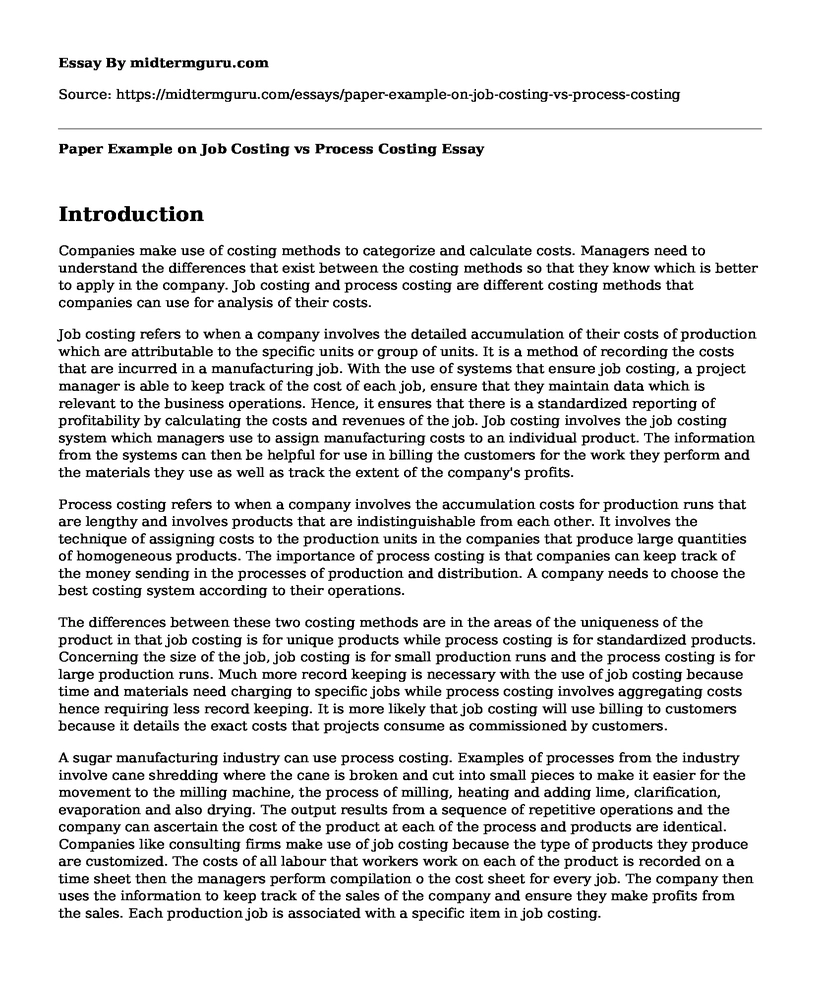Introduction
Companies make use of costing methods to categorize and calculate costs. Managers need to understand the differences that exist between the costing methods so that they know which is better to apply in the company. Job costing and process costing are different costing methods that companies can use for analysis of their costs.
Job costing refers to when a company involves the detailed accumulation of their costs of production which are attributable to the specific units or group of units. It is a method of recording the costs that are incurred in a manufacturing job. With the use of systems that ensure job costing, a project manager is able to keep track of the cost of each job, ensure that they maintain data which is relevant to the business operations. Hence, it ensures that there is a standardized reporting of profitability by calculating the costs and revenues of the job. Job costing involves the job costing system which managers use to assign manufacturing costs to an individual product. The information from the systems can then be helpful for use in billing the customers for the work they perform and the materials they use as well as track the extent of the company's profits.
Process costing refers to when a company involves the accumulation costs for production runs that are lengthy and involves products that are indistinguishable from each other. It involves the technique of assigning costs to the production units in the companies that produce large quantities of homogeneous products. The importance of process costing is that companies can keep track of the money sending in the processes of production and distribution. A company needs to choose the best costing system according to their operations.
The differences between these two costing methods are in the areas of the uniqueness of the product in that job costing is for unique products while process costing is for standardized products. Concerning the size of the job, job costing is for small production runs and the process costing is for large production runs. Much more record keeping is necessary with the use of job costing because time and materials need charging to specific jobs while process costing involves aggregating costs hence requiring less record keeping. It is more likely that job costing will use billing to customers because it details the exact costs that projects consume as commissioned by customers.
A sugar manufacturing industry can use process costing. Examples of processes from the industry involve cane shredding where the cane is broken and cut into small pieces to make it easier for the movement to the milling machine, the process of milling, heating and adding lime, clarification, evaporation and also drying. The output results from a sequence of repetitive operations and the company can ascertain the cost of the product at each of the process and products are identical. Companies like consulting firms make use of job costing because the type of products they produce are customized. The costs of all labour that workers work on each of the product is recorded on a time sheet then the managers perform compilation o the cost sheet for every job. The company then uses the information to keep track of the sales of the company and ensure they make profits from the sales. Each production job is associated with a specific item in job costing.
Cite this page
Paper Example on Job Costing vs Process Costing. (2022, Oct 03). Retrieved from https://midtermguru.com/essays/paper-example-on-job-costing-vs-process-costing
If you are the original author of this essay and no longer wish to have it published on the midtermguru.com website, please click below to request its removal:
- Steve Jobs: Revolutionary Leader
- Corporate Social Responsibility: Organizational Learning and Change Management
- Rational Strategic Planning - Essay Example
- Research Paper on Organizational Leadership
- Incentives Case Study
- Research Paper on Strategic Urbanization of Information Technology and Planning
- Essay Sample on Ethical Leadership of Modern-Day Tool Kit







